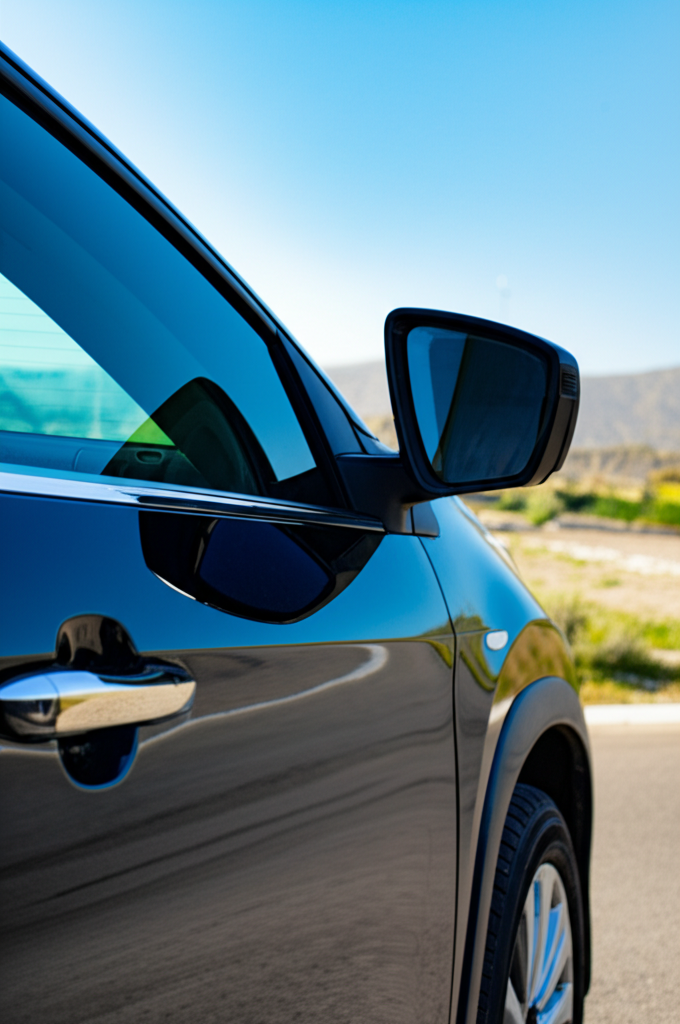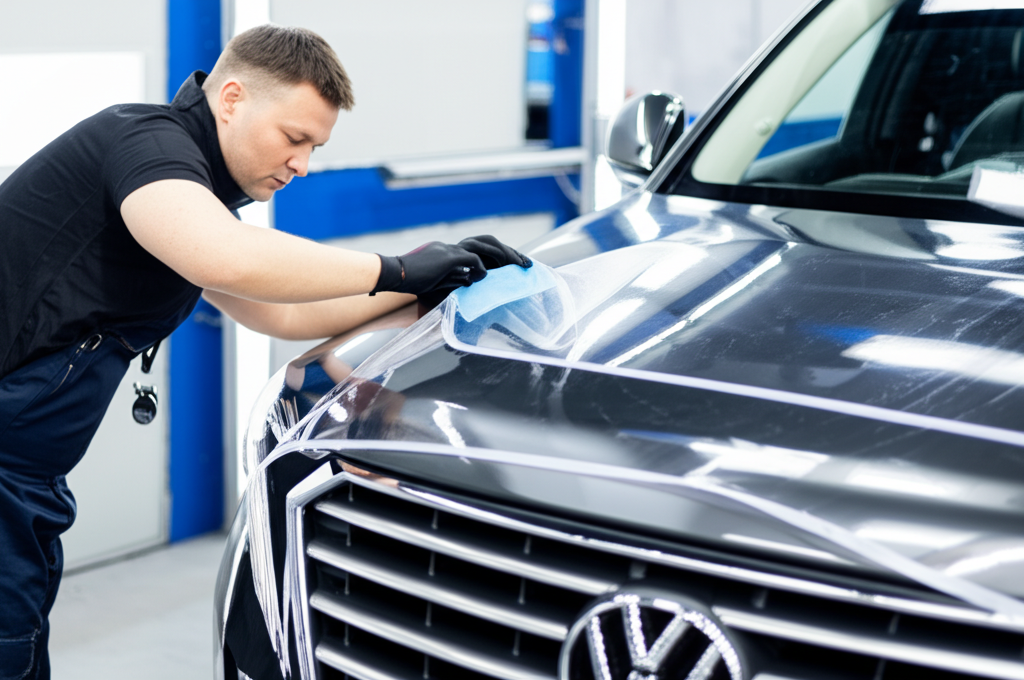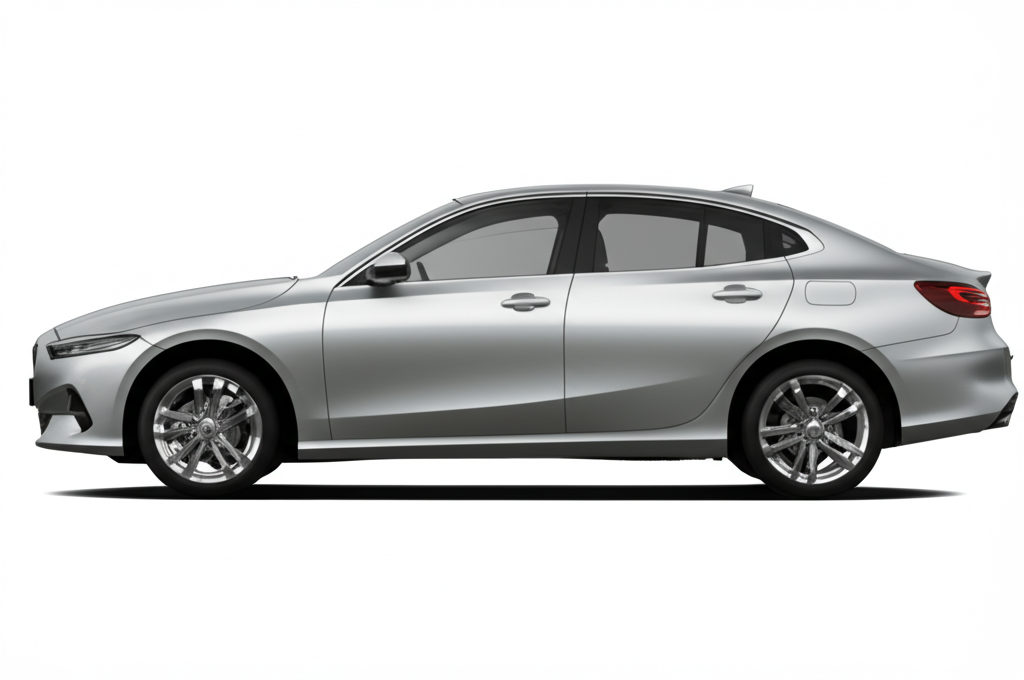You’ve just driven your gleaming new car off the dealership lot in Bangkok. The feeling is exhilarating! It’s perfect – the colour, the shine, the ‘new car smell’. You plan to enjoy it thoroughly, but you also have a strategic eye on the future. You know you’ll likely upgrade in about three years. As the initial excitement settles, a nagging worry creeps in, especially considering Thailand’s bustling traffic, unpredictable road debris, and sometimes harsh weather: “How do I keep this paint pristine? Will scratches, swirls, and minor dings significantly drop its resale value when it’s time to sell?” It’s a valid concern. A car’s appearance heavily influences its perceived value. So, the big question arises: Is investing in high-quality Thermoplastic Polyurethane (TPU) Paint Protection Film (PPF) a smart move if you only plan to keep the car for three years?

Meet Khun Veerapat: A Pragmatic Approach to Car Ownership
Khun Veerapat, a project manager working in Chonburi, recently purchased a new Mazda CX-5. He loves the car’s Soul Red Crystal Metallic paint but is keenly aware of its susceptibility to scratches. His daily commute involves navigating busy highways and tight city parking spots – prime environments for accidental paint damage. “I learned my lesson with my previous car,” Veerapat shares. “Minor scratches from parking mishaps and highway debris really added up. When I sold it after four years, the buyer negotiated the price down quite a bit, citing the poor paint condition. It cost me thousands of baht in potential value.”
This time, Veerapat has a clear 3-year plan before upgrading to an EV. Determined not to repeat past mistakes and maximize his resale return, he researched paint protection options. While ceramic coatings offered gloss and easier cleaning, they provided minimal physical protection against scratches and stone chips – his primary concerns. Cheaper PVC films were tempting price-wise but known for yellowing quickly and potentially damaging the paint upon removal. Ultimately, he decided that premium TPU PPF was the most logical investment, even for a relatively short ownership period. He opted for a full front-end wrap (bonnet, bumper, fenders, mirrors) and protection for the door cups and edges – high-impact areas. The installation took a couple of days at a reputable Bangkok auto spa. “Seeing the film applied was reassuring,” he notes. “It’s virtually invisible, but I know it’s there, acting like a shield. The peace of mind driving daily, especially on the motorway, is immense. I don’t flinch anymore when I hear gravel ping off the front.” Veerapat sees the PPF cost not just as an expense, but as insurance for his car’s future value.

Understanding Your Options: TPU PPF vs. Alternatives
When considering paint protection, it’s crucial to understand the different technologies available and how they stack up, especially for a 3-year timeframe focused on resale value.
TPU (Thermoplastic Polyurethane) PPF: This is the gold standard in paint protection film. It’s a durable, flexible, transparent layer applied directly to your car’s paintwork. Key characteristics include:
- Excellent Scratch Resistance: Effectively absorbs impacts from small stones, road debris, keys, and parking scuffs.
- Self-Healing Properties: Minor scratches and swirl marks often disappear with exposure to heat (sunlight or a heat gun).
- UV Protection: Helps prevent paint fading and oxidation caused by Thailand’s strong sun.
- Chemical & Stain Resistance: Protects against bird droppings, bug splatter, tree sap, and acid rain.
- Optical Clarity & Gloss Enhancement: High-quality TPU films are virtually invisible and can even enhance the paint’s natural gloss.
- Longevity: Typically lasts 5-10 years, easily covering a 3-year ownership period without degradation like yellowing or cracking (unlike older PVC films).
How does TPU PPF compare to other options?
| Feature | TPU PPF | PVC Film | Ceramic Coating | Wax / Sealant | Doing Nothing |
|---|---|---|---|---|---|
| Protection Level | Excellent physical (scratches, chips, stains) | Moderate physical (can brittle) | Good chemical/UV, minimal physical | Minimal chemical/UV, no physical | None |
| Self-Healing | Yes (most premium brands) | No | No | No | No |
| Durability / Lifespan | 5-10+ years | 1-3 years (prone to yellowing/cracking) | 1-5+ years (depending on quality/maintenance) | Months | N/A |
| Cost (Thailand Estimate) | High (฿30,000 – ฿150,000+ depending on coverage/car) | Low-Medium (฿15,000 – ฿50,000) | Medium (฿10,000 – ฿40,000) | Low (DIY or ฿1,000 – ฿5,000 per application) | Zero upfront cost |
| Impact on 3-Year Resale Value | Potentially High Positive (preserves pristine paint) | Potentially Negative (if yellowed, cracked, or damages paint on removal) | Slight Positive (maintains gloss, easier cleaning) | Minimal | Negative (accumulated scratches, chips, fading reduce value) |
| Best Suited For (3-Year Plan) | Owners prioritizing maximum paint preservation for resale value and peace of mind. | Very budget-conscious owners (with awareness of risks). Not generally recommended. | Owners wanting gloss & easy cleaning, less concerned about physical impacts. Can complement PPF. | Basic upkeep, minimal investment. | Owners accepting paint degradation and potential resale value hit. |
For a 3-year ownership cycle where maximizing resale value is a key objective, TPU PPF stands out. While the upfront cost is higher, it directly addresses the primary factor that visually depreciates a car: paint damage. Preserving the factory finish in near-perfect condition after three years of typical Thai driving conditions can easily translate to a higher selling price, potentially recouping a significant portion, if not all, of the PPF investment compared to a car with visible wear and tear.
Voices from the Road: Owner Experiences
“I was hesitant to spend so much on PPF for my new BMW X1, knowing I’d probably sell it in 3-4 years. But my commute on the Vibhavadi Rangsit highway means constant exposure to debris. After getting a full front wrap, I feel so much more relaxed. A few months ago, a large piece of gravel hit the hood hard – I saw it happen. Checked later, not a single mark on the paint, just a tiny scuff on the film that buffed out. That incident alone convinced me it was money well spent for preserving its future value.”
– Khun Anong, Bangkok
“My Fortuner is my family workhorse, often navigating tight soi and provincial roads. I opted for TPU PPF on the bumpers, door edges, and hood right after buying it, planning to keep it for about 3 years before getting a newer model. It wasn’t cheap, but the thought of avoiding those annoying parking lot scratches and keeping the ‘new car look’ for longer appealed to me. It just makes the car feel more premium and protected. I believe it will definitely help when I trade it in.”
– Khun Somchai, Nonthaburi
“Initially, I thought PPF was overkill for just three years. I considered just a ceramic coat for my Civic Type R. But I know how easily performance car paint gets chipped on spirited drives or track days, even occasional ones. Protecting that Championship White paint was key for resale. The TPU film gives me confidence to enjoy the car without constantly worrying about minor damage depreciating its value significantly when it’s time to sell.”
– Khun Alex, Phuket
These owners, initially weighing the cost against their ownership timeline, found that the peace of mind and anticipated preservation of resale value justified the investment in TPU PPF.
Is It Your Turn to Protect Your Investment?
You’re planning ahead, looking three years down the road. You want to enjoy your car now without the constant stress of potential paint damage, and you want to get the best possible price when it’s time to sell. In Thailand’s driving environment, scratches, stone chips, and environmental damage are not just possibilities; they’re near certainties over a three-year period.
Investing in high-quality TPU Paint Protection Film acts like a safety net for your car’s aesthetic appeal and, consequently, its financial value. It’s about proactively preventing the very damage that buyers use to negotiate prices down. If the thought of losing thousands or even tens of thousands of Baht at resale due to paint condition concerns you, then TPU PPF becomes a strategically sound decision, even for a 3-year hold.
Ready to explore how TPU PPF can safeguard your car’s value? Contact us for a personalized consultation and quote based on your vehicle and needs.
📱 Want to learn more about car wrap & paint protection?
Feel free to reach us on LINE:

🌐 Official Website: https://tpuwraps.com
Frequently Asked Questions (FAQ)
- Q: Is TPU PPF really necessary if I’m only keeping the car for 3 years?
- A: It depends on your priorities. If maximizing resale value and minimizing worry about paint damage are important, then yes, it’s highly beneficial. The cost of PPF can often be offset or even exceeded by the retained value compared to a car with noticeable paint flaws after 3 years of use in Thailand. Consider it an investment in maintaining the car’s condition.
- Q: What’s a realistic cost for TPU PPF installation in Thailand?
- A: Prices vary based on the quality of the film, the size of your car, the extent of coverage (e.g., front end only vs. full car), and the reputation of the installer. Expect to invest anywhere from ฿30,000 for basic front-end protection on a small car to ฿150,000 or more for a full wrap on a large SUV or luxury vehicle using premium film.
- Q: Will removing the PPF after 3 years damage my original paint?
- A: If you use a high-quality TPU film and have it professionally removed, it should not damage the underlying factory paint. Reputable films use adhesives designed for safe removal. Problems usually arise from cheap (often PVC) films or improper removal techniques.
- Q: Why choose TPU PPF over much cheaper PVC films?
- A: TPU films offer superior clarity, durability, flexibility, UV resistance, and often self-healing properties. PVC films tend to yellow, crack, or become brittle relatively quickly (sometimes within 1-2 years, especially in strong sunlight), and their adhesives can sometimes damage paint upon removal. For preserving value over 3 years, TPU is the far safer and more effective choice.
- Q: Can I just get a ceramic coating instead for 3 years?
- A: Ceramic coatings primarily provide enhanced gloss, hydrophobicity (making the car easier to clean), and some resistance to chemical etching and UV rays. They offer very minimal protection against physical impacts like scratches and stone chips. PPF provides robust physical protection. They serve different purposes, though they can be used together (PPF first, then ceramic coating on top).
Conclusion: Protecting Your Asset, Preserving Your Peace of Mind
Owning a car in Thailand for three years means exposing it to numerous potential hazards that can degrade its paintwork. While the initial cost of TPU Paint Protection Film might seem substantial for a shorter ownership period, its value lies in its ability to shield your car from the physical and environmental damage that directly impacts resale value. Think of it less as an expense and more as an insurance policy for your car’s appearance and your future finances.
By maintaining a pristine, factory-fresh look, you not only enjoy a better-looking car during your ownership but also position yourself for a significantly higher return when it’s time to sell or trade-in. For the discerning owner planning a 3-year cycle, TPU PPF offers a tangible way to combat depreciation caused by cosmetic wear and tear, ensuring your vehicle remains a valuable asset. Don’t let avoidable scratches chip away at your investment – protect it wisely from day one.
